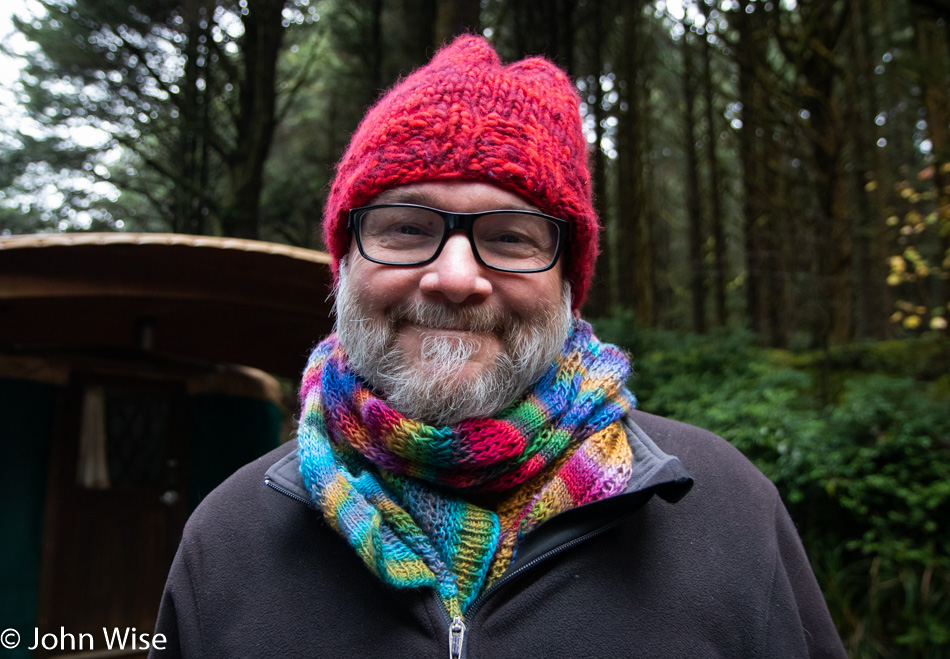
If I’ve got to be an old man, I’m happy to be this one in the photo. Gone from those eyes are the angst of youth. I see a guy happy and comfortable where he’s at, cozy too, with all that wool wrapping him up warmly. Like many others have said before me and have done so with a flair, while the youth may be gone from my appearance, it still rages hard within my spirit. Of course, my wife might interpret that as me still being half an idiot or that I’ve forgotten that I’m technically the age of a grandpa, though she’d also insist that I’ve mastered the poor humor of such an old guy.
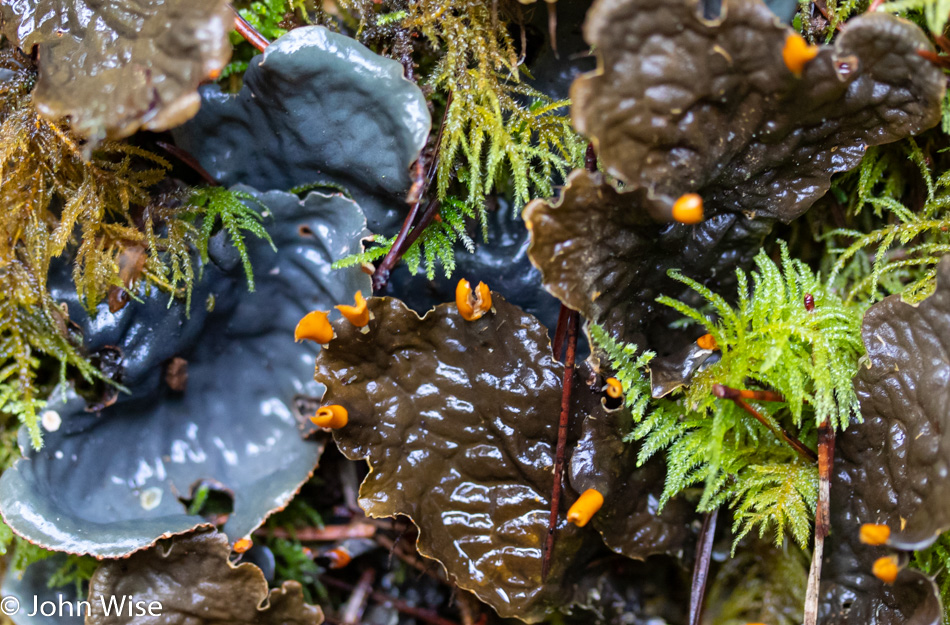
Can you find Disneyland in a cold, wet rainforest on the central coast of Oregon under gray skies? We can; it’s right here at Carl G. Washburne State Park on the China Creek loop trail. What I mean to say is that this trail we’ve taken countless times here has all of the appeal and entertainment value of a place others hold as an essential must-visit at least once in your life kind of place.
Take this lichen here that is commonly called dog lichen; it belongs to the Peltigera genus of lichens of which there are 91 species. How do we know this? Caroline went on a super-sleuthing task after I failed to find anything about it while searching for variations of mushrooms and fungi. Once she identified this as lichen, it took another half-hour until she stumbled upon the name of the orange things, which turn out to be ascocarps and are part of the reproductive structure of the lichen, carrying spores. So, this particular species appears to be Peltigera membranacea.
Along the way, while researching this and then getting lost following a ton of other threads, Caroline came across a lichen called Icmadophila ericetorum which has a way cool common name: Fairy Barf.
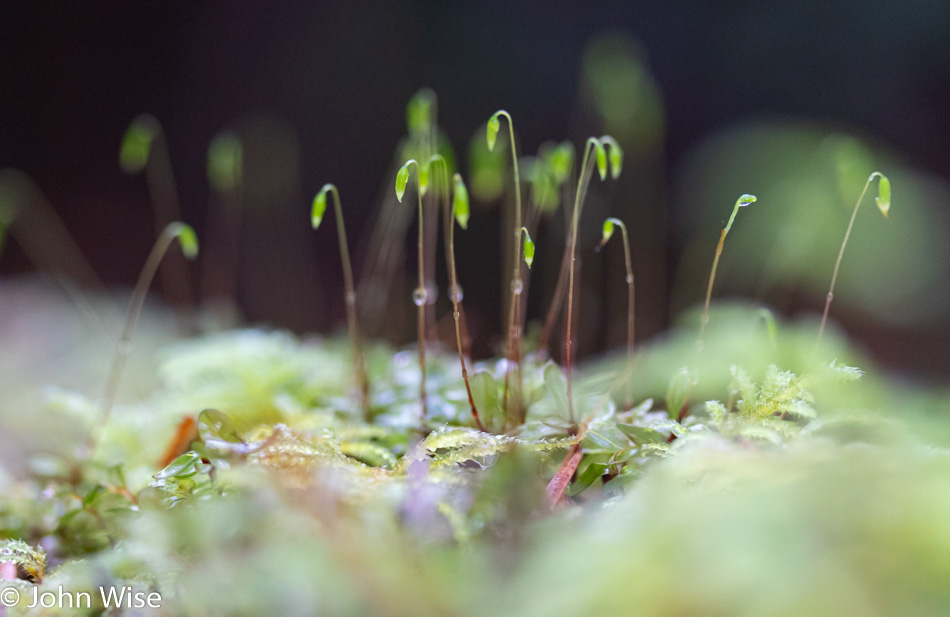
There are no thrill rides here, but there are thrilling views that will never all be seen, no matter how often you visit. This forest is dynamic, and while many things, such as the trees, seem to remain static at first blush, if you look closer, you’ll soon notice that is impossible. Even if I marked the location of this tiny garden of some sort of sprouts (or maybe they are fully grown, but tiny plants), whatever they are, I’d bet a dollar this wouldn’t look the same a week from now.
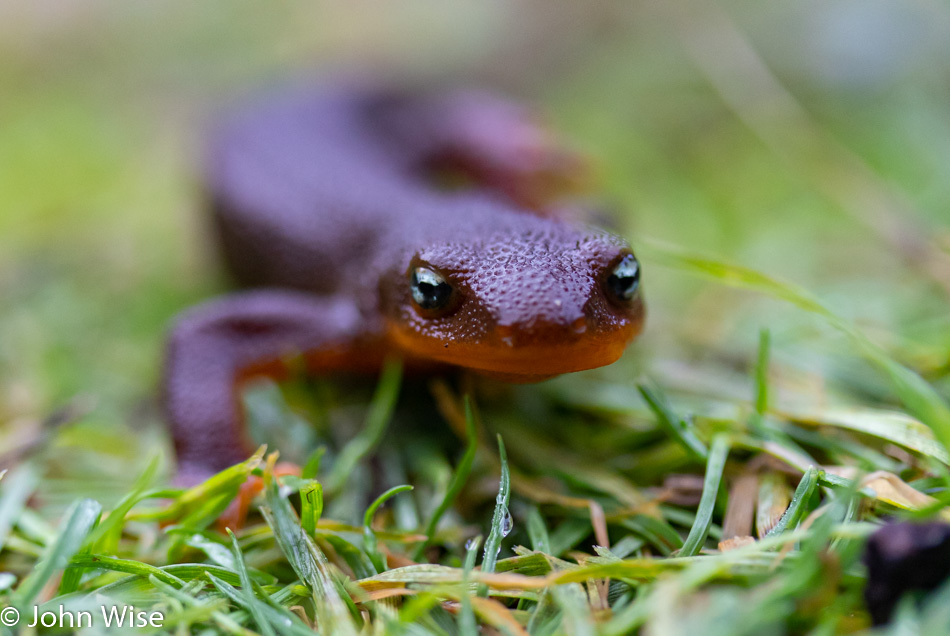
Look at a newt from where you stand, and you’ll likely think to yourself that not only is their gate a strange one, but their pace is on the slow side. Now get down at their level and put a camera in front of them so you can attempt to get a close-up of their face, and you’d swear they were pretty snappy in their step. We learned some time ago that they are mildly toxic with a substance on their orange undersides that is an irritant. Considering that this likely occurs when they are threatened, we’ve decided not to pick them up anymore to admire their beautiful eyes, feet, and locomotion of their curious steps.
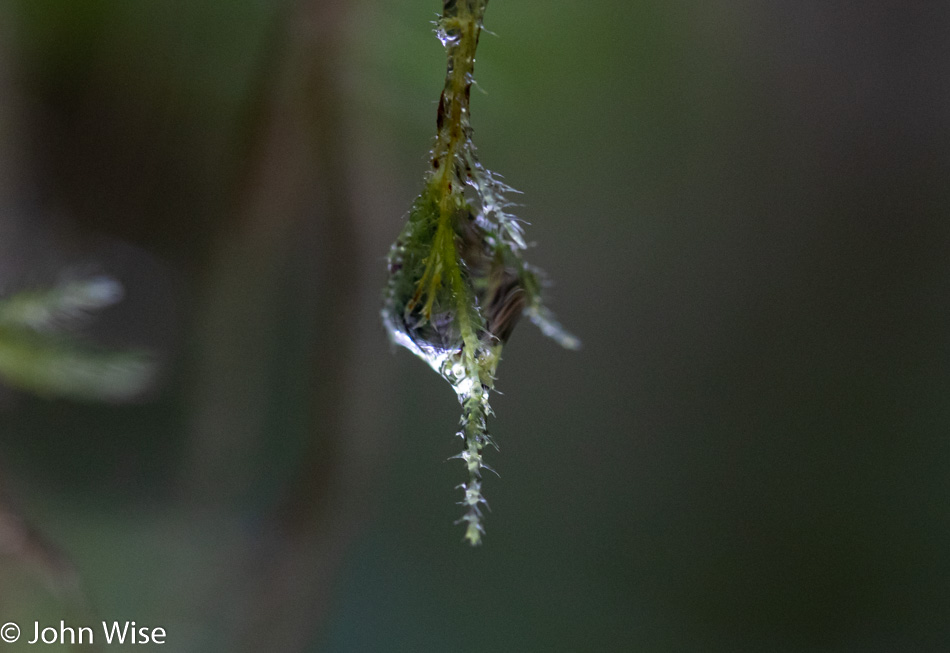
While just three atoms make up a molecule of water, there are 5.01 x 10²¹ atoms in a drop of water. I can’t tell you how many drops of water are in this photo hanging from this bit of a plant. The plant itself is made of cells that are as complex as human cells, with its own DNA for passing on genetic traits and RNA for making proteins, etc. The number of cells in a gram of plant or animal tissue is another exponential number like the one above for water, though not as many. My point is that we are looking at trillions of atoms and at least billions of molecules in a complex system where water has to be exchanged with the plant and the cells in the plant, transferring information through a complex network of channels while growth is at work.
Most of us will look at images such as these and never comprehend the complexity of just what’s before us. We’ll go through life ignorant of how symbiotic the entire interplay of atoms is for the support of life, not just ours but of all the systems that must work as a tight patchwork of essential subsystems in an ecosphere where consciousness took flight. If only humanity could see this intrinsic nature of reality, we might come to the conclusion and realization that we are coexisting in a fragile environment that could only benefit from more awareness of its greatest destroyer.
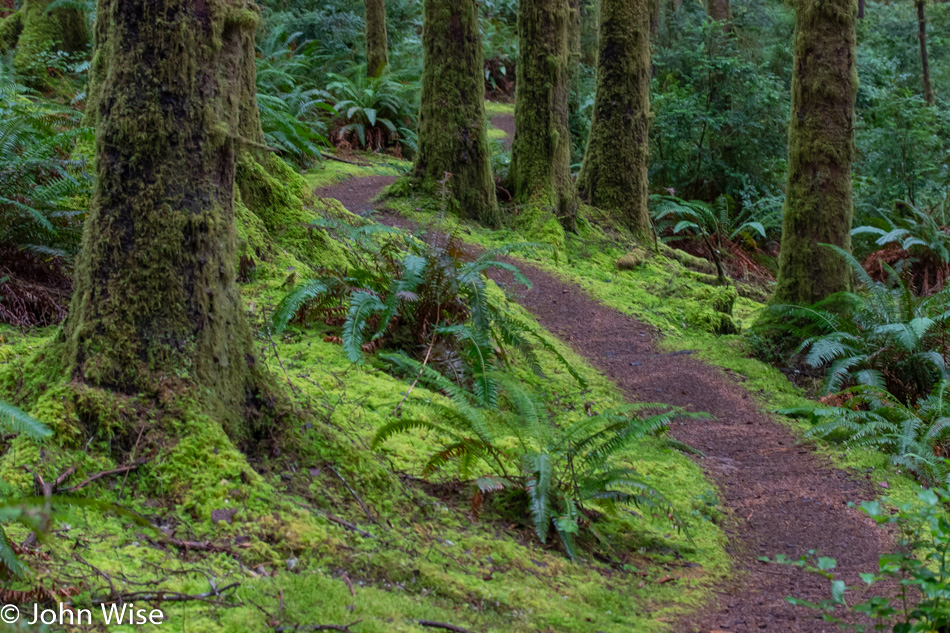
Now, extrapolate the numbers above to just this section of trail in one incredibly small corner of a place somewhere on the coast of a single state that is actually a tiny spot of a continent and try to realize how relatively insignificant your own bag of cells is to the bigger picture. You are so incredibly lucky to have all of the attributes of consciousness with sensing organs to move through the infinity of a reality that might be the only one you’ll ever know. Do you decide to take advantage of this awareness and maybe find delight in the undiscovered sights, sounds, and potential knowledge that is all around you, or are you content in a staid existence where you allow yourself to remain in situ like so much moss on the forest floor?
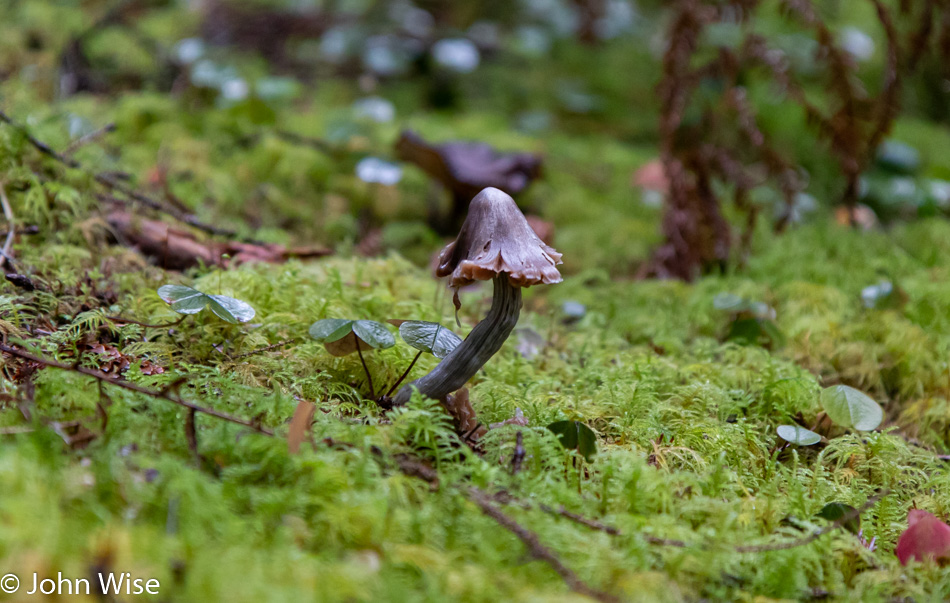
If I told you that I witnessed a tiny elf scurry out from under this mushroom, would you really be able to challenge me? I could tell you that it exists in a spectrum of light invisible to your vision and that its body is made of a mix of nitrogen, argon, carbon dioxide, oxygen, hydrogen, and various particles, all using photons as their energy source while harnessing neutrinos as a communication network. What I’ve just described is exactly what you are seeing that is invisible in this image: the air we breathe. While neutrinos are not used for communication as far as we currently know, I’d like to postulate that we may not yet know if things from the ether are able to exist outside of our realm of knowledge. Now, to be honest, I did not see an elf, gnome, fairy, or sprite dancing under the mushroom cap or scurrying out of sight, but that doesn’t mean there wasn’t magic being captured of the reality before my eyes.
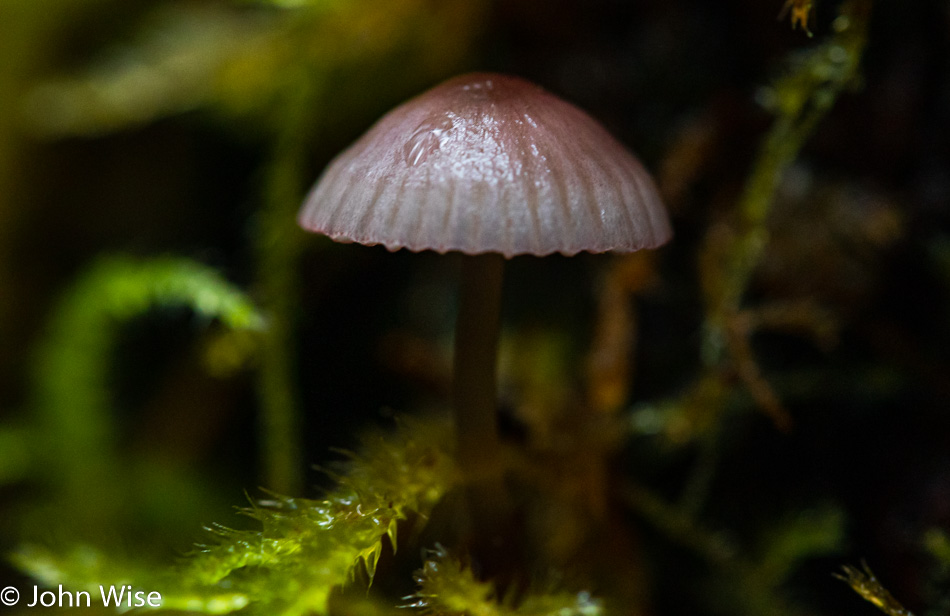
The whispers of the forest are faint, but their poetry of hushed tones might be heard if you remain still and observant of the relationship of things that create this universe. We cannot truly experience this world where spiders can take refuge out of sight or are in plain sight but have merged into the natural camouflage of the environment. On the surface of what we see are yeasts and bacteria we cannot see. Without learning more, how can we ask the right questions or begin to guess what their role is here in the shaded woods? The roots, tendrils, webs, and invisible trails through the thicket are alive and teeming with life; try as I might, I cannot grasp the order or balance of things. Now if this is a Liberty Cap mushroom, which I’m in no way certain of, though I think we could be in agreement that the opportunity to find psychedelic mushrooms across the Oregon landscape is a given, then we can dig another step deeper into questioning why is nature supplying itself with hallucinogens if it is not in some way self-aware?
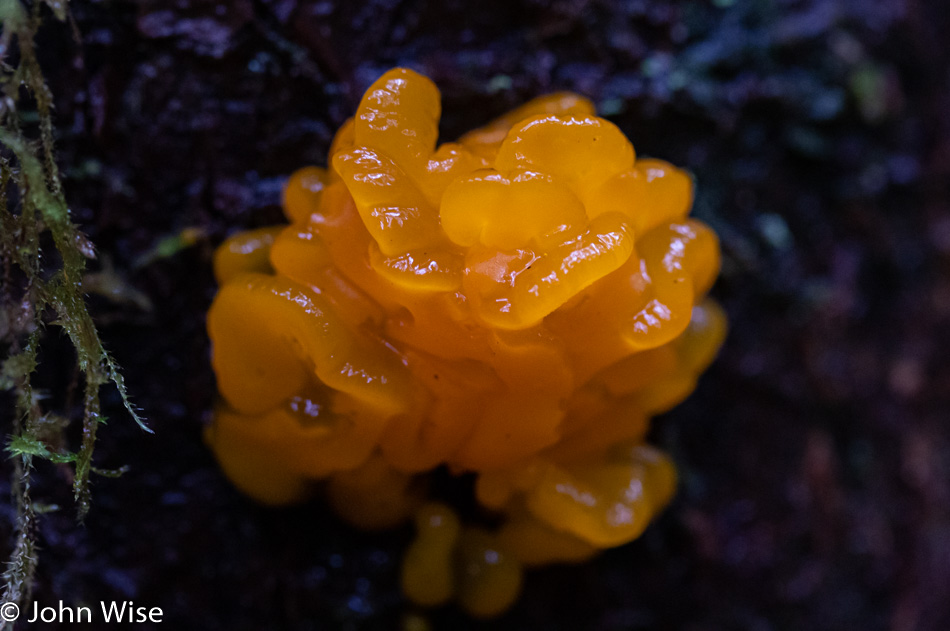
Witch’s butter, as it’s sometimes known, is also orange jelly fungus, or by its Latin name, Dacrymyces palmatus. This fungus grows on wood, and while we didn’t know it at the time, it is edible. While walking along, it’s easy for bright contrasting colors to catch our eye even when they are tiny spots in the larger picture, such as the ones up near the top of this blog entry. So if the brighter colors draw our eyes in, what about all the species that miss our casual gaze and blend into the scenery, not wanting to be seen?
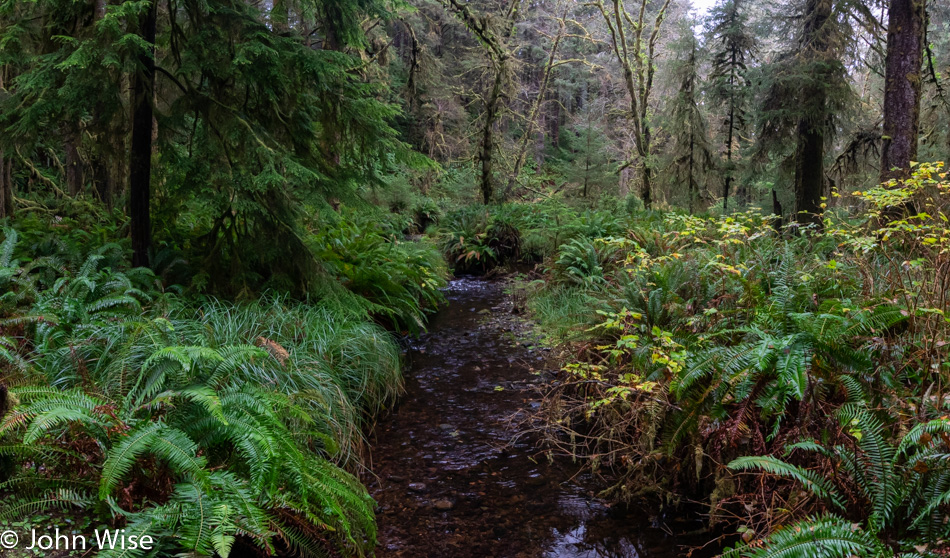
This is China Creek, and while I’m uncertain if this is true, I believe it’s the first image of the trail’s namesake I’ve shared here on the blog.
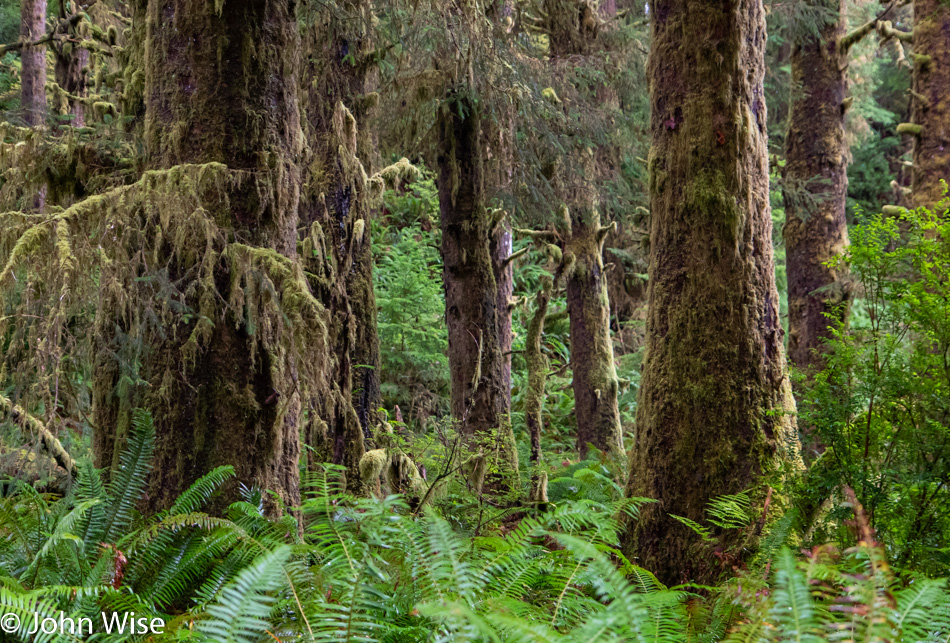
All great old things grow beards. Old dogs have white whiskers on their chins. My wife has the occasional goat hair popping off of her still soft and delicate chin; I’m sure she doesn’t mind me sharing that. True, young hipsters have beards, too, but that’s just because they recognize that on the path to greatness, one must possess a tuft of hair on the bottom half of their face to allow for focused contemplation. Trees are the masters of beards. Moss must have come about in order to demonstrate wisdom as it grows in places where reverence of things extraordinary and wise is apparent.
I noted above that there are 91 species of lichen, and while they are the granddaddies of the plant kingdom, having appeared over 550 million years ago, there are nearly 10,000 species of mosses. These hairy fellows are relative youngsters who have only been hanging out in our woods for about 290 million years, but you have to admit their prolificness.
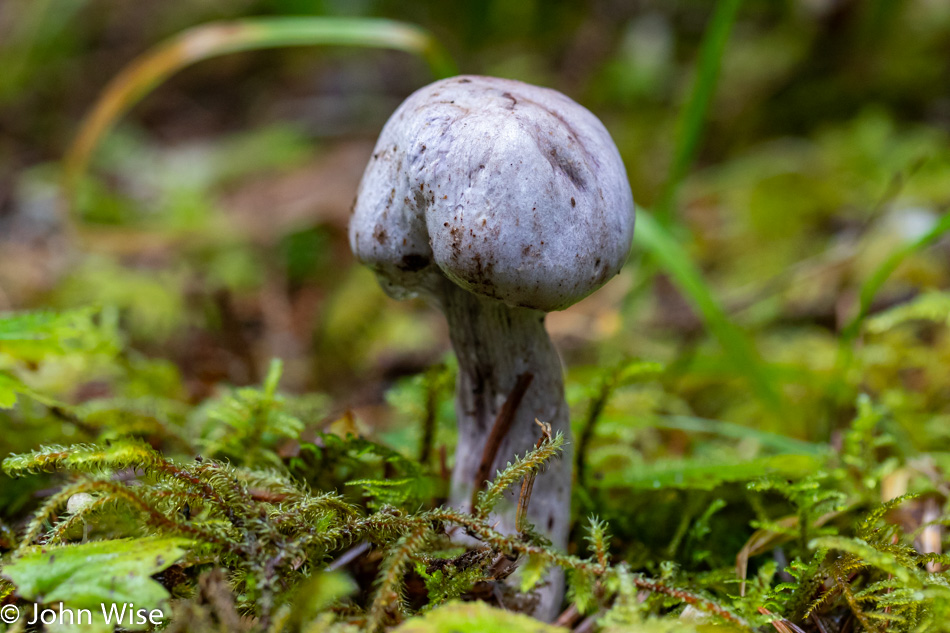
A phallic appearance was not the intention when I knelt down to capture this blue-gray mushroom poking out of the forest floor, but phallic is what I got. So, beyond the obvious comparison, what else is there to know about this particular mushroom? I don’t really know, as I’m not going on a search to identify exactly what it is, but I can share some interesting facts about mushrooms for those who might be curious.
There are four major categories of mushrooms. The first is the saprotrophs that help decompose the materials around them. They recycle organic waste by releasing acids and enzymes that digest the dead matter, which in turn feeds the mushroom. Then there are the parasitic mushrooms that take over plants, ultimately killing them so the Mushroom King might live on, kind of virus-like really. Mycorrhizal mushrooms rely on a more symbiotic relationship with plants, where they supply nutrients to the plant while the plant offers a food source the fungus needs to survive. Finally, there are the endophytes. Endophytic fungi are essentially parasites, too, but they do not kill their host. One last item of note, there are over 10,000 species of mushrooms currently known. If you can send me an email listing the names of all of them you’ll be entered in a contest to win some undetermined gift. Exciting stuff, huh?
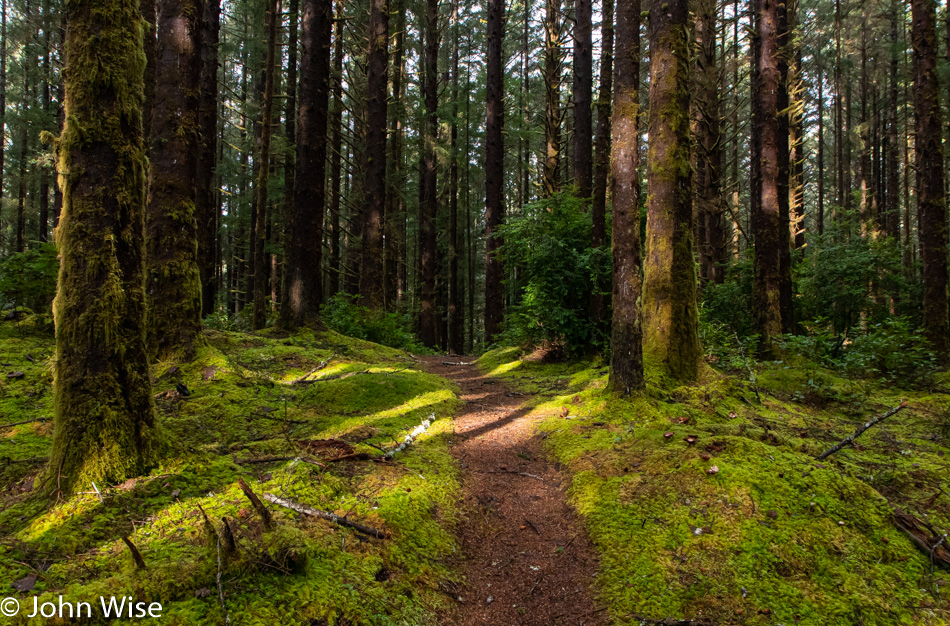
Okay, so the mushroom trivia may not be the most exciting content here on JohnWise.com, but this photo of sunlight falling on the mossy forest, spilling over trees, and warming our cockles should bring out some happy cheer from those of you fortunate enough to know how terrific sunshine feels to those in a rainforest late in November.
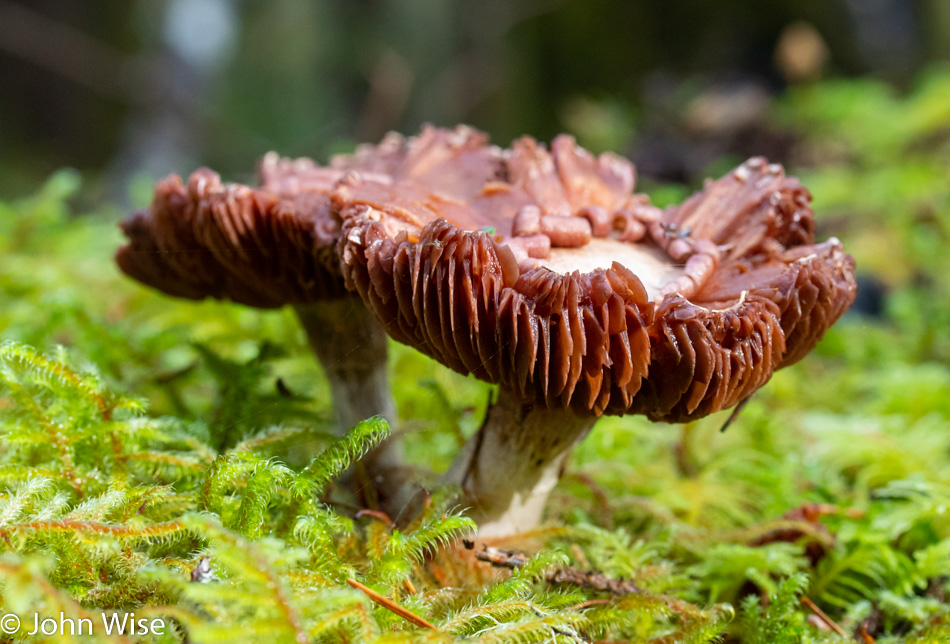
You’ll beg for me to stop posting all the mushroom, fungus, liverwort, lichen, and moss photos by the time this day is finished. If I had a microscope with me, I’d also be taking photos of the cyanobacteria, a.k.a. blue-green algae, to share with you. Speaking of cyanobacteria, did you know that there are only 2,698 described species of this branch of algae out of an estimated total of 6,280 cyanobacteria species? Not only that, but it’s been estimated there are between 30,000 and 1,000,000 different species of algae; just imagine if there were even a couple of dozen species of humans walking the earth. And no, idiots are not a species unto themselves.
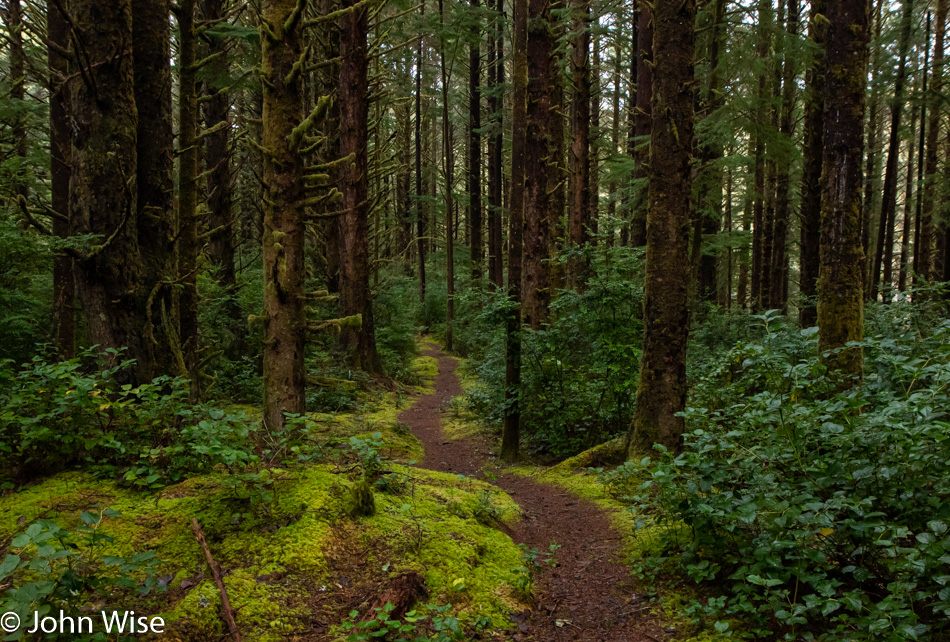
That’s about it, as the trail simply disappears into the edge of the forest where we and everything we’ve ever known or seen ceases to exist. This is the black hole of the rainforest where the event horizon is paved in electric green psychedelia. On the other side, we emerge 20 minutes younger though that might also be attributed to the fact that our hearts and minds have sung themselves into younger versions of the people that entered this magic land.
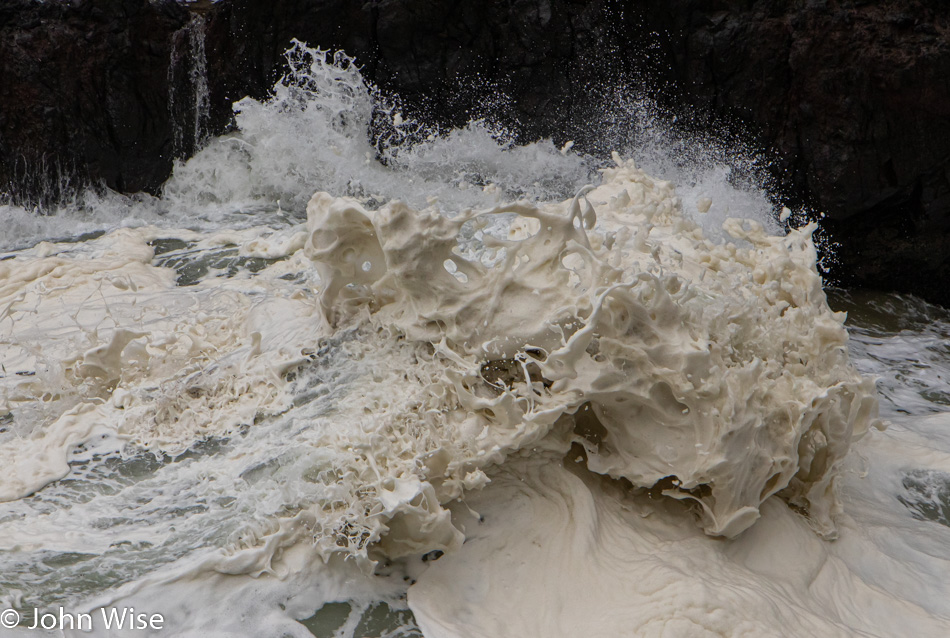
The Devil’s Churn at Cape Perpetua in Lincoln County, Oregon, could also be known as the place where John will have to take hundreds of photos in an attempt to capture the ferocity of the frothing gnarl of the sea that comes crashing into a narrow inlet, building up explosive energy as the water is compressed with nowhere to go but up. I could sit here for hours watching these fluid sculptures exist and disappear in fractions of seconds. I never really considered this before, but maybe these are quantum communication forms that have been transmitted to us by an alien species that believes everyone knows how to read chaos in the churning foam.
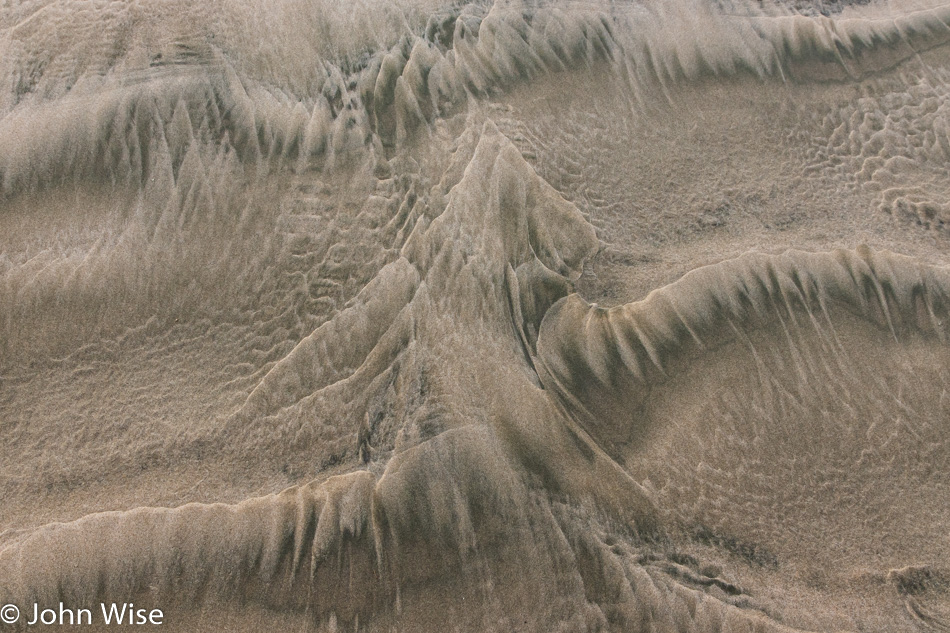
Just out of frame due to poor photography skills by the author is the signature of Bob Ross, dated 1994. I think I might have found my very own version of a Banksy image painted right here in the Oregon sand.
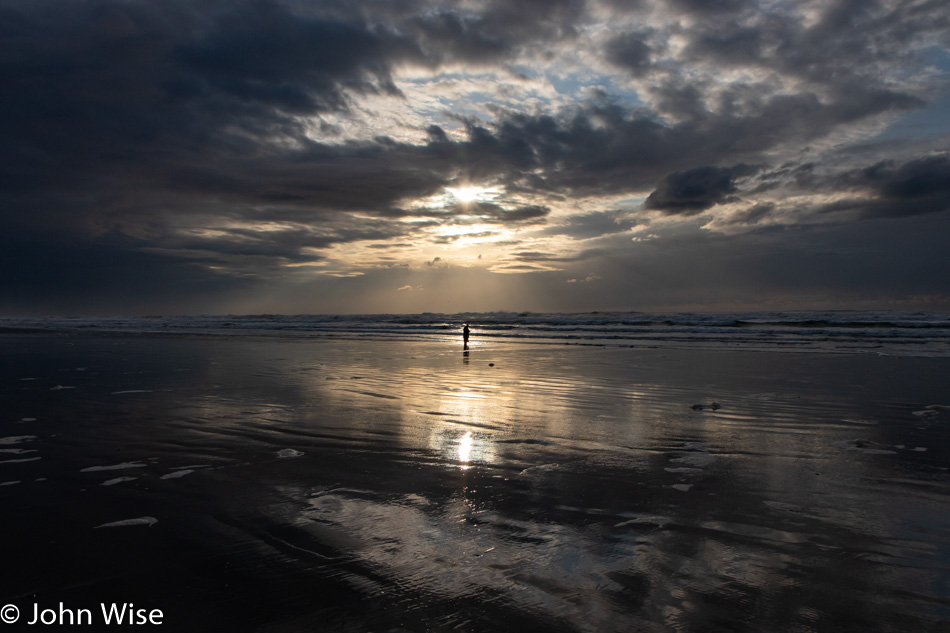
If you are starting to wonder if this day ever ends, the answer is a resounding NO! The impressions we gathered will live on with us, and while they can never be experienced by anyone else, we appreciate that they are uniquely ours. Nobody can ever go back and see these things just as we did. While everyone can watch a rerun of Game of Thrones and see the same things millions of others have seen, our adventures into reality, painted with the filters of interpretation we bring into our imaginations, will never be known or fully understood. We choose to the best of our abilities to be the atom on the beach that is part of the molecule creating the scene which becomes the cells making up the body of reality.
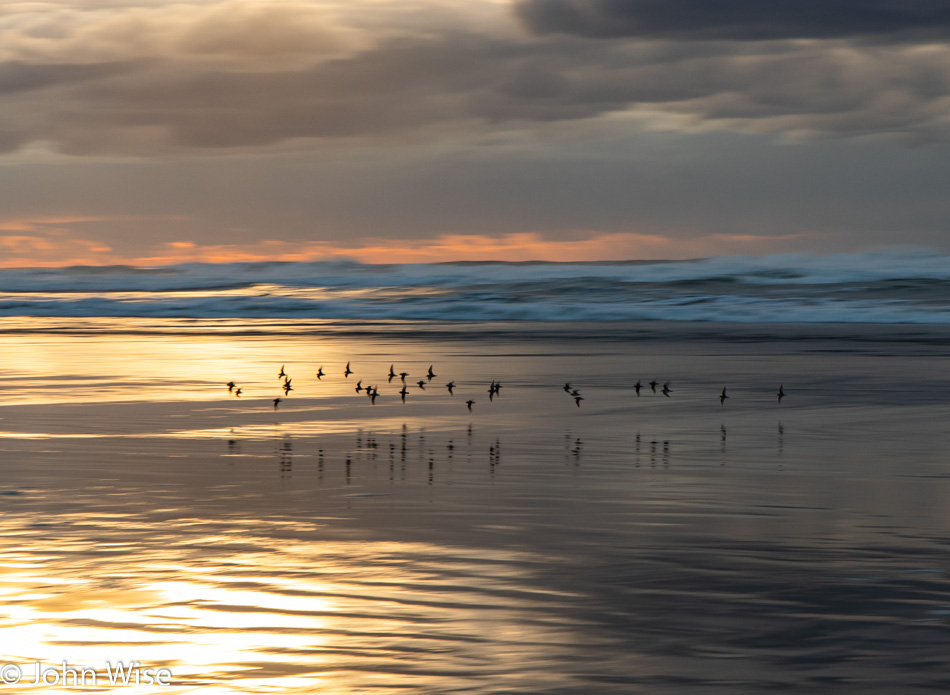
The reality we perceive is a fleeting image like these plovers who, for a moment, lend themselves to an unimaginable scene but just as quickly flock in what is nearly a murmuration to fly away, never to be seen again. You then must ask yourself, were you trying to witness your own reality enhanced by the serendipity of life’s rare moments, or were you content to remain fixed to your chair, staring into the abyss of nothing?
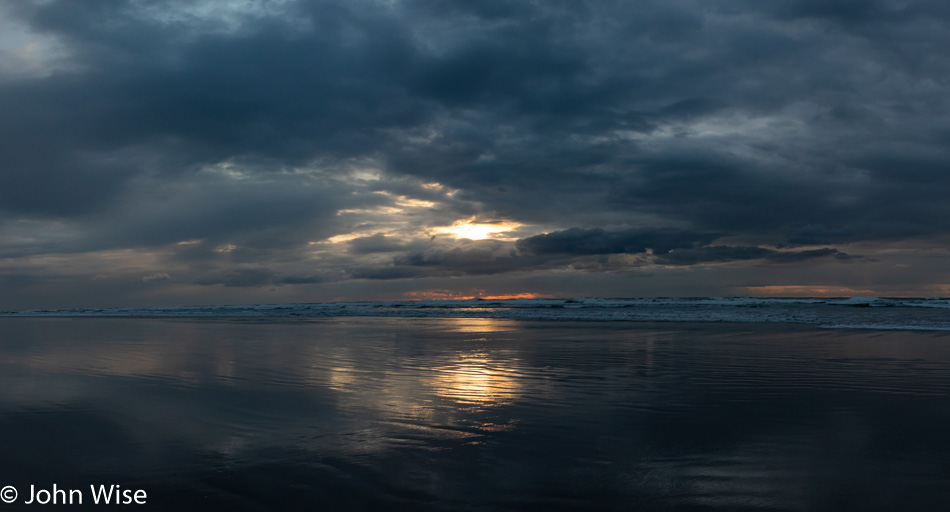
The light is fading fast with hopes that the impressions it helped illuminate will persist long into the days that see us growing older. This is how you live 100 days in one.